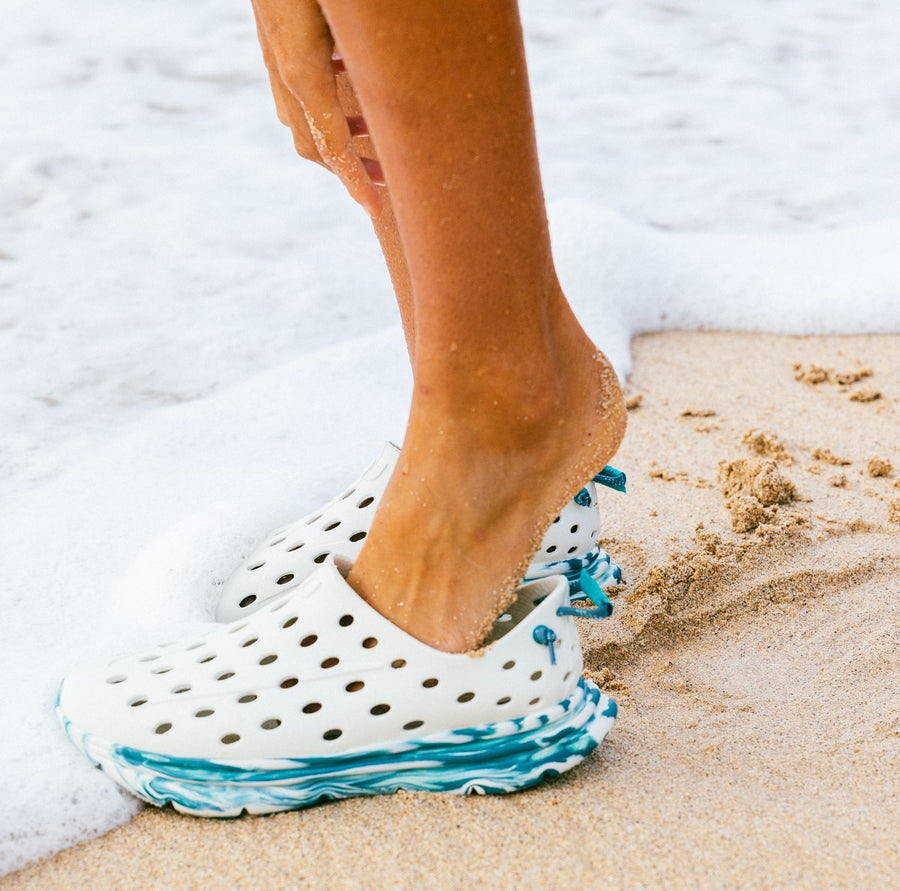Muscle fatigue vs. muscle soreness
Understanding the sensations our bodies experience during and after physical activity is critical to optimizing our workouts and recovery routines. Two common yet often misunderstood aspects of exercise are muscle fatigue and muscle soreness.
While they both arise from physical exertion, they represent distinct physiological processes with unique symptoms and implications for training. In this blog post, we delve into the differences between muscle fatigue and muscle soreness, shedding light on what causes them and how to manage them effectively.
Whether you're a seasoned athlete or new to the fitness scene, grasping these distinctions can empower you to navigate your workout regimen with greater insight and efficiency.
The difference between muscle fatigue and muscle soreness
If you've ever had to steel yourself to tackle a set of stairs after swimming or cycling (or any exercise where the muscle is shortening, i.e., concentric contractions), you've experienced muscle fatigue.
"You can swim for hours, you can cycle for hours. And you burn fuel, but you don't really get super sore; you get more tired," Shona Halson, recovery scientist and former director of the Australian Olympic Committee's Recovery Centre, told ABC News.
At the other end of the spectrum, when you participate in activities that involve lengthening muscles (i.e., eccentric contractions), such as running or contact sports, when you're making impact with the ground or another player, the connections between the muscle fibers can break. This microscopic breakage results in inflammation and swelling, which can cause soreness.
Muscle soreness can also happen when we work our muscles more rigorously than usual or engage groups we don't usually use.
"Weight training is another type of exercise typically associated with soreness," Halson said. "You have some shortening muscle contractions, but you also usually have some lengthening contractions, and it's those lengthening contractions that cause the soreness."
Muscle fatigue tends to resolve itself quickly, while soreness can linger for as long as 72 hours as the muscle fibers repair themselves.
What is normal soreness following a workout, and when should you seek help?
Muscle pain is common for 24 to 72 hours after new or heavy eccentric exercise. Some even consider soreness a good thing—a sign that you've fully challenged your body.
However, there are possible causes for soreness that require medical attention. Consider speaking to a healthcare professional in the following situations:
- If the soreness lasts longer than 72 hours after the workout. Normal muscle soreness typically resolves within 24 to 72 hours, but chronic pain could indicate something more serious.
- If the soreness is so intense that it prevents you from completing your normal daily activities, such as going to work or performing other regular tasks.
- If the soreness is localized to a specific area and causes significant discomfort. This may indicate an injury rather than general muscle soreness. Pain in both legs usually suggests you overdid it during your workout, but localized pain may signal an injury.
- If the soreness does not improve with light exercise, massage, physical therapy, or other recovery methods. While these techniques can help reduce delayed onset muscle soreness (DOMS), the soreness should resolve on its own regardless. If it doesn't, it could be a sign of something more serious.
9 common causes of muscle soreness and muscle fatigue
Muscle soreness is a common complaint among fitness enthusiasts, but the cause is complex, according to Maryland-based physical therapist Gene Shirokobrod. “The answer is we still don’t know,” he told The New York Times.
While muscle soreness and muscle fatigue are different experiences, there are factors influencing both, including:
1. Exercise intensity and duration
Microtears in the muscles during exercise cause delayed onset muscle soreness. A regular part of muscle growth and adaptation, these tears trigger an inflammatory response that leads to fatigue and soreness.
Eccentric exercises, where the muscle lengthens under tension, are particularly effective at causing DOMS. Examples include bicep curls, squats, and deadlifts.
2. Overexertion
Overuse or overexertion of muscles during physical activity or exercise, especially if it's a new or more intense activity, can lead to muscle soreness. Not allowing sufficient time for recovery between workouts can also lead to overexertion, causing more severe soreness and potentially increasing the risk of injury.
Overdoing it during a workout can also lead to muscle fatigue. This occurs as muscles use up energy stores, accumulate metabolic byproducts, and experience microtears from repeated contractions.
3. Injury or strain
Muscle injuries, such as sprains or strains, can result in soreness and fatigue, as can overexerting muscles during exercise or daily life. This can happen due to improper form, lifting weights that are too heavy, or sudden movements that strain the muscles beyond their normal range of motion.
4. Inadequate warm-up or cool-down
Proper warm-up and cool-down routines are crucial for preparing your muscles for exercise and aiding recovery after an intense workout. Skipping these routines can leave your muscles more susceptible to stiffness, soreness, and injury.
5. Dehydration
Staying hydrated is vital to muscle performance and recovery because water facilitates the transport of nutrients and removes waste. Dehydration can increase the likelihood of soreness and fatigue, so stay hydrated before, during, and after exercise for best results.
6. Nutrient deficiencies
Protein, magnesium, potassium, and vitamin D are essential to keep muscles functioning optimally and recovering well. Not getting enough of these nutrients (in the form of nutritional supplements or through food) can impair muscle repair and increase the risk of soreness and fatigue.
7. Inactivity
Muscles tend to stiffen and get sore if you're not exercising regularly. Engaging in high-intensity exercise or prolonged activity following a period of inactivity can cause soreness and fatigue. Regular movement and exercise help maintain muscle flexibility, improve athletic performance, and reduce the likelihood of severe workout soreness.
8. Illness or infection
Certain medical conditions and infections, such as influenza and other viral infections, can cause aches and pains. Wait until you're feeling better to exercise.
9. Lack of sleep
Lack of sleep can result in muscle soreness, as the body needs rest to recover and repair muscle tissue. According to the Harvard Medical School, sleep quality matters as much as sleep duration. Most adults should get at least seven hours of sleep a night, but if you wake up feeling refreshed, "worry less about the exact number of hours you're sleeping."
The best ways to reduce soreness and fatigue after a workout
The best way to recover after a workout involves a combination of strategies aimed at promoting muscle repair, glycogen replenishment, hydration, and reducing inflammation. Combine these practices to minimize soreness and maximize recovery:
Cool down and stretch
After your workout, spend five to 10 minutes doing light stretching and mobility exercises to help relax muscles and promote recovery. This can help reduce muscle soreness and tension.
Apply ice and heat
Applying ice for 20 to 30 minutes can reduce swelling and pain, while applying heat can stimulate blood flow and ease tightness after exercising muscles.
Hydrate
Drink 16 to 24 ounces of water or other hydrating fluids like coconut water or milk to replenish fluids lost through sweat. Staying hydrated is beneficial for many reasons, including helping regulate body temperature, preventing cramps, and transporting nutrients to muscles.
Refuel with protein and carbs
Eat a snack or meal with a mix of protein (e.g., whey protein powder, eggs, Greek yogurt, tofu, quinoa, salmon, chicken or other lean meats) and carbs within 45 minutes of finishing your workout. This helps provide energy and replenish muscle glycogen stores and amino acids for muscle repair and growth.
Get light exercise on rest days
Do light activities like walking, swimming, or yoga on rest days to promote blood flow. This can help reduce soreness and stiffness without overexerting the muscles.
Get sleep and manage stress
Aim for at least seven hours of quality sleep per night to give your body time to recover and repair. Manage stress levels, as high stress can impair the body's ability to heal.
Discover Kane Recovery Shoes!
Kane's recovery shoes provide excellent support, comfort, and durability for those in need of top-notch recuperative footwear. Featuring an adjustable hook-and-loop single strap synthetic upper, plush TPR footbed, as well as a durable injected EVA outsole, these kicks come with all the right features to assist you during your rehabilitation journey.
Aside from providing quality products, they are also committed to sustainability, having made plans to become a B Corp while dedicating 1% of their overall profits towards environmental charities.
When and how to wear Kane Revive
The best moment to wear most recovery shoes is directly after a strenuous activity such as running or exercising. This helps minimize inflammation and launch the healing process. To guarantee maximum comfort and effective recuperation, make sure that you are wearing your recovery footwear correctly by tying up laces securely for a snug fit.
Frequently asked questions
What causes muscle soreness and fatigue?
Overexertion, aging, medical history, medications, and nutritional deficiencies are the primary causes of sore muscles and fatigue. Proper rest, hydration, nutrition, and treatment of any underlying conditions can help alleviate muscle problems and improve performance.
Why does my body feel weak, tired, and sore?
There are several key reasons why your body may feel weak, tired, and sore:
- Exercise and physical activity: Strenuous exercise and physical exertion can lead to muscle fatigue, soreness, and weakness.
- Aging: Muscle strength and endurance tend to decline as people age. Older adults may experience increased muscle fatigue, soreness, and weakness, especially with physical activity.
- Certain medical conditions: Various health conditions can cause or contribute to muscle fatigue, soreness, and weakness, including Addison's disease, anemia, cancer, dehydration, depression, fibromyalgia (a.k.a. chronic fatigue syndrome), hepatitis C, hypothyroidism, inflammatory diseases such as rheumatoid arthritis, and more.
- Medications: Some medications, such as corticosteroids and cholesterol-lowering statins, can induce muscle fatigue and weakness as a side effect.
- Nutrient deficiencies: Lacking certain nutrients, such as magnesium, can impair muscle function and lead to fatigue.
- Infections and viruses: Illnesses like the flu, common cold, and COVID-19 can leave the body feeling weak, tired, and achy due to the immune system's inflammatory response. Wait until you feel better to resume regular exercise.
When should I be worried about body aches?
You should seek medical attention if your body aches are severe, persistent, or accompanied by other concerning symptoms such as fever, rash, difficulty breathing, unexplained weight loss, or joint swelling.
It's also wise to consult a doctor or other healthcare professional if your aches interfere significantly with your daily activities or don't improve with rest and self-care. They can help identify the underlying cause of your symptoms and provide appropriate treatment or guidance.
What are the symptoms of muscle fatigue?
Symptoms of muscle fatigue can include:
- Muscle weakness: An initial sign of muscle fatigue is a decreased ability to produce force and move the muscles as usual
- Soreness or aching in the muscles: A dull ache or soreness in the affected muscles often accompanies muscle fatigue
- Difficulty performing daily tasks: Muscle fatigue can make carrying out regular physical activities and daily tasks more challenging
- Exhaustion and lack of energy: Muscle fatigue leads to tiredness, lack of energy, and feeling overwhelmed
- Reduced exercise tolerance: Muscle fatigue can limit a person's ability to sustain physical activity and exercise for as long as usual
- Impaired muscle performance: Muscle fatigue decreases the force, power, and endurance of the affected muscles
What are potential treatments for muscle fatigue?
Some potential treatments for muscle fatigue include:
- Synthetic products: Amphetamines, ephedrine, and caffeine can promote resistance to muscle fatigue, though these are sometimes banned in sports. Caffeine, in particular, can help reduce muscle fatigue after exercise, such as running or weight training.
- Natural products: Red ginseng and raw garlic may help relieve muscle fatigue.
- Nutritional supplements: Dietary supplements like multivitamins or fish oil can help provide nutrients that may be lacking and contributing to muscle fatigue.
- Other treatments: Regular massage and gentle stretching can improve blood flow, reduce muscle tension, and alleviate fatigue. Over-the-counter anti-inflammatory medications like ibuprofen can help reduce inflammation and pain associated with muscle fatigue.
If muscle fatigue persists or worsens, consult a healthcare professional who can identify or rule out an underlying health condition affecting the energy systems used during exercise.
What is skeletal muscle fatigue?
Skeletal muscle fatigue is the decline in a muscle's ability to generate force or power during physical activity.
The key characteristics of skeletal muscle fatigue include weakness, soreness or aching, difficulty performing daily tasks, exhaustion and lack of energy, reduced exercise tolerance, and impaired muscle performance.
Neural factors, such as reduced nerve signaling, and metabolic factors within the muscle cells themselves, such as depletion of energy stores and the buildup of metabolic byproducts, can cause muscle fatigue. Proper rest, nutrition, and treatment of underlying conditions can help alleviate muscle fatigue.





















